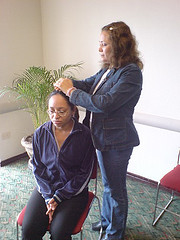 “I tried rekei [sic] not to long again and it was amazing,” says survivor EMB. “Don’t know how it works, all I know is that I felt better.”
“I tried rekei [sic] not to long again and it was amazing,” says survivor EMB. “Don’t know how it works, all I know is that I felt better.”
“I was given a Reiki session as a gift from a friend,” says survivor kfinnigan. “I was soooo amazed at the gal that did the session. She only knew that I had bc [breast cancer] and did her thing…she said after the session that she had to really dig and dig through my left shoulder area to clear the path there for balance and I told her that was my surgery side and all my lymph nodes were taken out. She said that explains it! I felt balanced and energized afterward.”
“I’m also a Reiki practitioner,” says Pbcc1, “and I can tell you it works. Most patients have less side effects and are more peaceful than those not receiving the treatments.”
Reiki (pronounced “ray-kee”) is an ancient healing practice that originated in Japan, with a foundation in ancient Tibetan Buddhism. It is used to promote health and well-being, or to ease disease-related symptoms or side effects. The word Reiki is derived from two Japanese words: rei, or universal, and ki, or life energy. The idea is that there is a universal (or source) energy that supports the body’s innate healing abilities. Practitioners access this energy, helping it to flow into the body to facilitate healing, often through 12–15 basic positions or energy centers on the body (chakras). They direct Reiki energy through the palms of the hands to the patient, who normally sits or lays down fully clothed. A treatment can last anywhere from 30–90 minutes.
The National Center for Complementary and Alternative Medicine (NCCAM) is currently funding research on the effectiveness of Reiki on cancer-related side effects and symptoms. As of 2001, 47% of U.S. state nursing boards recognized providing alternative therapies including Reiki as being with the scope of nursing practice. “We use probably 50-80 percent of nonpharmacologic methods in our NIH pain clinic,” says Ann Berger, R.N., M.S.N., M.D. Chief of the Pain and Palliative Care Service at the National Institute of Health in Washington, D.C. “The things we use include massage, relaxation, hypnosis, and Reiki therapy, which is also very helpful in fibromyalgia and chronic fatigue syndromes.”
Many cancer centers provide Reiki sessions on site, or have recommendations for practitioners. If you need to find one on your own, reiki.org suggests you look in health magazines, health-food stores, and local new-age publications, and ask for recommendations from new-age bookstores and massage therapists. The International Association of Reiki Professionals (IARP) provides a locator page, and About.com has a practitioner directory for both the U.S. and Canada, as does The Reiki Page.
When you do find a practitioner you’re considering, ask questions like these:
- How long have you been practicing Reiki?
- What qualifications do you have? (Look for completed classes, membership in Reiki organizations, and/or time with a master. Currently there are no certifications.)
- How long will each treatment take? How many treatments do you recommend?
In the end, go with the person that feels right. What matters is that you feel better-without more drugs. Leigh Leming, a breast-cancer survivor, tried Reiki during her second bout with the disease, receiving treatments prior to chemo. “I actually forgot to take my pain pills after a Reiki session,” she says.
Have you found Reiki helpful in dealing with cancer treatments? Please share your experiences.
Photo courtesy of reikigendai via Flickr.com.

